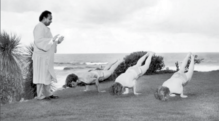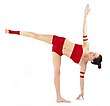Bishnu Charan Ghosh
Bishnu Charan Ghosh (24 June 1903 – 9 July 1970), known as B. C. Ghosh, was a Bengali bodybuilder and Hathayogi. He was a younger brother of the yogi Paramahansa Yogananda, who became world-famous through his 1946 book Autobiography of a Yogi. In 1923 he founded the College of Physical Education, Calcutta. His writings influenced the development of modern yoga as exercise in India when they were taken up by Bikram Choudhury, founder of Bikram Yoga.
B. C. Ghosh | |
|---|---|
 | |
| Born | 24 June 1903 |
| Died | 9 July 1970 (aged 67) |
| Nationality | Indian |
| Occupation | Bodybuilding |
| Known for | Modern yoga, training Bikram Choudhury |
The annual yoga championships in Los Angeles are contested for the Bishnu Charan Ghosh Cup, named in his honour.
Life

Bishnu Charan Ghosh was born in Lahore, the youngest of eight children of Bhagabati Charan Ghosh (1853–1942) and brother of Mukunda Lal Ghosh, better known by his spiritual name, Paramahansa Yogananda.[1][2] His parents' guru was Lahiri Mahasaya, who taught Kriya Yoga.[2]
Yogananda introduced Ghosh to yoga at his Ranchi School for Boys in Bengal, where he was one of the first seven pupils. As well as Yogananda's set of 84 "Yogoda" asanas gathered from different sources, his brother taught him the dramatic abdominal muscle isolation exercise traditionally used in hatha yoga as the purification (shatkarma) known as nauli; Yogananda had used the exercise to impress Western audiences with his muscle control. In 1923, at the age of twenty, Ghosh opened the College of Physical Education in Calcutta, today run by his granddaughter Muktamala Ghosh under the name Ghosh's Yoga College. In 1925, he trained in physical education at the University of Calcutta, taught according to India's traditional (medieval) physical culture of training, diet, and lifestyle. The equipment consisted of rough "nal" stones with a hole for use as a handle.[1][3][4]
In 1930 he published his book Muscle Control, which relied heavily on the German bodybuilder Maxick (Max Sick)'s 1913 book of the same name.[5][1][2] The book features his adoptive nephew, Buddha Bose, demonstrating nauli and uddiyana bandha; Bose wrote a manuscript on 84 Asanas, not published until the 21st century.[6]
In 1939 Ghosh went to America and taught at Columbia University, New York. In 1968 he went on a lecture tour of Japan.[2]
Philosophy
Bishnu's muscle control was strongly influenced by Yogananda's Method Yogoda, as described in his 1925 book on that subject,[7] which in turn was based on Maxick's Maxalding technique. This "Body Perfection by Will" relied on the use of weights and special apparatus for musclebuilding. Added to this was the weaving in of traditional asanas from Hatha yoga; he became well-known in India as a Hathayogi, teaching a yoga that was "a fusion of asanas, physical culture, and the muscle manipulation techniques that Ghosh had first learned from his brother".[1][8][2]
The yoga researcher Mark Singleton has argued that Ghosh's method contributed significantly to the development of modern postural yoga.[1] It has been stated that Ghosh also influenced the development of Sivananda Yoga's sequence of 12 basic asanas.[9]
Legacy
Ghosh's Yoga College in North Kolkata continues to offer training in therapeutic yoga in the 21st century.[10]
Bikram Choudhury, creator of Bikram Yoga, claimed to have been taught by Ghosh from the age of four (in 1948). However, he actually began studying yoga in 1969, and he was not instructed by Ghosh directly. His system of yoga was based on Ghosh's writings.[11][12] Choudhury named the Bishnu Charan Ghosh Cup, awarded annually at the International Yoga Asana Championships in Los Angeles, in Ghosh's honour.[13][14][15]
Pupils
- Monotosh Roy (1917–2005), who in 1951 became the first Indian bodybuilder to win the title of Mr. Universe.[16][17][18]
Works
- B.C. Ghosh and K.C. Sen Gupta: Muscle Control and Barbell Exercise. College of Physical Education, Calcutta, 1930.
References
- Singleton 2010, pp. 132–135.
- Knight, Bonnie (11 October 2014). "Bishnu Charan Ghosh and His Influence on Modern Postural Yoga". History of Modern Yoga. Retrieved 27 March 2019.
- Newcombe, Suzanne (2017). "The Revival of Yoga in Contemporary India" (PDF). Religion. Oxford Research Encyclopedias. 1. doi:10.1093/acrefore/9780199340378.013.253. ISBN 9780199340378.
- "Bishnu Ghosh Biography". Bikram Yoga Vancouver. 8 July 2012. Archived from the original on 3 September 2013. Retrieved 27 March 2019.
- Maxick 1913.
- Armstrong, Jerome. "Buddha Bose | 84 Asanas". Buddha Bose. Archived from the original on 4 June 2019. Retrieved 16 December 2019.
- Paramahansa Yogananda: General Principles and Merits of Yogoda or Tissue-Will System of Body and Mind Perfection, Originated and Taught by Swami Yogananda. Los Angeles 1925.
- Ghosh 1980, p. 249.
- Singleton 2010, p. 135.
- "Ghosh's Yoga College Teacher Training". Retrieved 16 December 2019.
- Schickel, Erica (25 September 2003). "Body Work". L.A. Weekly. LA Weekly. Retrieved 21 November 2019.
- Henderson, Julia L. (2018). Bikram. 30for30, season 3, episodes 4&5. ESPN.
- "International Yoga Asana Championship". The New York Times. 12 June 2013. Retrieved 27 March 2019.
- Beck, Sara (11 June 2012). "Yoga Is Not Just Posing as Sport at World Event". The New York Times.
Silence prevailed during the yoga asana routines of the ninth annual Bishnu Charan Ghosh Cup ... Onstage, a garland-draped image of Bishnu Ghosh, Bikram’s guru, looked on while seven judges sat with pencils raised, critiquing the routines.
- Whitworth, Melissa (7 June 2010). "Are you cool enough for competitive yoga?". The Daily Telegraph.
- "The Indian Atlas". The Indian Express. 3 July 2005. Retrieved 6 April 2012.
- "Monotosh Roy". Sandow and the Golden Age of Iron Men: The Online Physical Culture Museum. Archived from the original on 27 December 2002. Retrieved 6 April 2012.
- "Monotosh Roy: The first Asian to be crowned Mr. Universe (1917 - 2005)". Mr. Universe 2011. Indian Bodybuilding and Fitness Federation. Archived from the original on 21 March 2012. Retrieved 6 April 2012.
Sources
- Singleton, Mark (2010). Yoga body : the origins of modern posture practice. Oxford University Press. ISBN 978-0-19-539534-1. OCLC 318191988.CS1 maint: ref=harv (link)
- Maxick (1913). Muscle Control, or Body Development by Will-Power. Ewart, Seymour & Co.CS1 maint: ref=harv (link)
- Ghosh, S. L. (1980). Mejda, the Family and Early Life of Paramahansa Yogananda. Los Angeles: Self-Realization Fellowship.CS1 maint: ref=harv (link)
